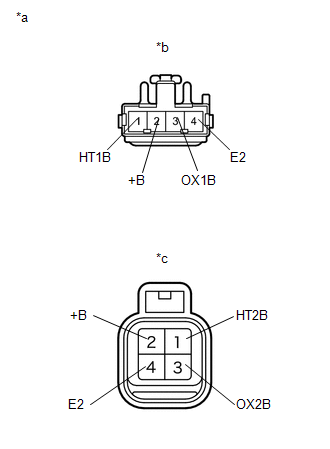-
Abnormal voltage output:
- During active air fuel ratio control, heated oxygen sensor voltage does not increase to 0.66 V or higher for certain period of time (2 trip detection logic)
-
Low impedance:
- Sensor impedance less than 5 Ω for 30 seconds or more when ECM presumes sensor is warmed up and operating normally (2 trip detection logic)
| Last Modified: 08-28-2024 | 6.11:8.1.0 | Doc ID: RM100000000VICF |
| Model Year Start: 2016 | Model: Sienna | Prod Date Range: [12/2015 - 08/2016] |
| Title: 2GR-FE (ENGINE CONTROL): SFI SYSTEM: P0136-P0139,P013A,P013C,P0156-P0159; Oxygen Sensor Circuit (Bank 1 Sensor 2); 2016 MY Sienna [12/2015 - 08/2016] | ||
|
DTC |
P0136 |
Oxygen Sensor Circuit (Bank 1 Sensor 2) |
|
DTC |
P0137 |
Oxygen Sensor Circuit Low Voltage (Bank 1 Sensor 2) |
|
DTC |
P0138 |
Oxygen Sensor Circuit High Voltage (Bank 1 Sensor 2) |
|
DTC |
P0139 |
Oxygen Sensor Circuit Slow Response (Bank 1 Sensor 2) |
|
DTC |
P013A |
Oxygen Sensor Slow Response - Rich to Lean Bank 1 Sensor 2 |
|
DTC |
P013C |
Oxygen Sensor Slow Response - Rich to Lean Bank 2 Sensor 2 |
|
DTC |
P0156 |
Oxygen Sensor Circuit (Bank 2 Sensor 2) |
|
DTC |
P0157 |
Oxygen Sensor Circuit Low Voltage (Bank 2 Sensor 2) |
|
DTC |
P0158 |
Oxygen Sensor Circuit High Voltage (Bank 2 Sensor 2) |
|
DTC |
P0159 |
Oxygen Sensor Circuit Slow Response (Bank 2 Sensor 2) |
DESCRIPTION
In order to obtain a high purification rate of the carbon monoxide (CO), hydrocarbon (HC) and nitrogen oxide (NOx) components in the exhaust gas, a TWC (Three-Way Catalytic Converter) is used. For the most efficient use of the TWC, the air fuel ratio must be precisely controlled so that it is always close to the stoichiometric air fuel level. For the purpose of helping the ECM to deliver accurate air fuel ratio control, a heated oxygen sensor is used.
The heated oxygen sensor is located behind the TWC, and detects the oxygen concentration in the exhaust gas. Since the sensor is integrated with the heater that heats the sensing portion, it is possible to detect the oxygen concentration even when the intake air volume is low (the exhaust gas temperature is low).
When the air fuel ratio becomes lean, the oxygen concentration in the exhaust gas is high. The heated oxygen sensor informs the ECM that the post-TWC air fuel ratio is lean (low voltage, i.e. less than 0.45 V).
Conversely, when the air fuel ratio is richer than the stoichiometric air fuel level, the oxygen concentration in the exhaust gas is low. The heated oxygen sensor informs the ECM that the post-TWC air fuel ratio is rich (high voltage, i.e. higher than 0.45 V). The heated oxygen sensor has the property of changing its output voltage drastically when the air fuel ratio is close to the stoichiometric level.
The ECM uses the supplementary information from the heated oxygen sensor to determine whether the air fuel ratio after the TWC is rich or lean, and adjusts the fuel injection duration accordingly. Thus, if the heated oxygen sensor is working improperly due to internal malfunctions, the ECM is unable to compensate for deviations in the primary air fuel ratio control.
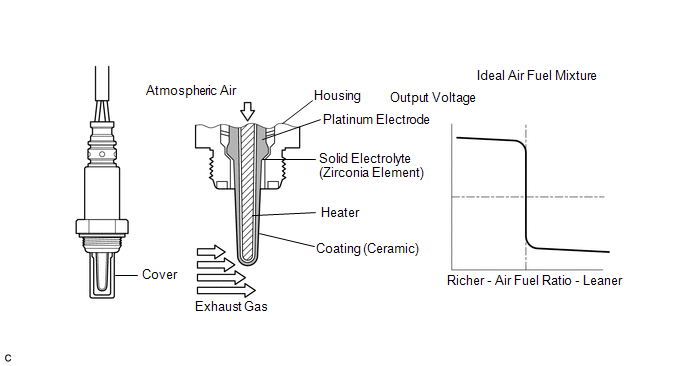
|
DTC No. |
DTC Detection Condition |
Trouble Area |
|---|---|---|
|
P0136 P0156 |
|
|
|
P0137 P0157 |
|
|
|
P0138 P0158 |
|
|
|
P0139 P0159 |
|
|
|
P013A P013C |
Heated oxygen sensor voltage does not drop from 0.35 V to 0.2 V immediately after fuel cut starts (1 trip detection logic) |
|
for Mexico Models
|
DTC No. |
DTC Detection Conditions |
Trouble Areas |
|---|---|---|
|
P0136 P0156 |
Not applicable |
None |
|
P0137 P0157 |
|
|
|
P0138 P0158 |
Not applicable |
None |
|
P0139 P0159 |
Not applicable |
None |
|
P013A P013C |
Not applicable |
None |
MONITOR DESCRIPTION
1. Active Air Fuel Ratio Control
The ECM usually performs air fuel ratio feedback control so that the air fuel ratio sensor output indicates a near stoichiometric air fuel level. This vehicle includes active air fuel ratio control in addition to regular air fuel ratio control. The ECM performs active air fuel ratio control to detect any deterioration in the Three-Way Catalytic Converter (TWC) and heated oxygen sensor malfunctions (refer to the diagram below).
Active air fuel ratio control is performed for approximately 15 to 20 seconds while driving with a warm engine. During active air fuel ratio control, the air fuel ratio is forcibly regulated to become lean or rich by the ECM. If the ECM detects a malfunction, a DTC is stored.
2. Abnormal Voltage Output of Heated Oxygen Sensor (DTCs P0136 and P0156)
While the ECM is performing active air fuel ratio control, the air fuel ratio is forcibly regulated to become rich or lean. If the sensor is not functioning properly, the voltage output variation is small. For example, when the heated oxygen sensor voltage does not increase to 0.66 V or higher during active air fuel ratio control, the ECM determines that the sensor voltage output is abnormal and stores DTC P0136 or P0156.
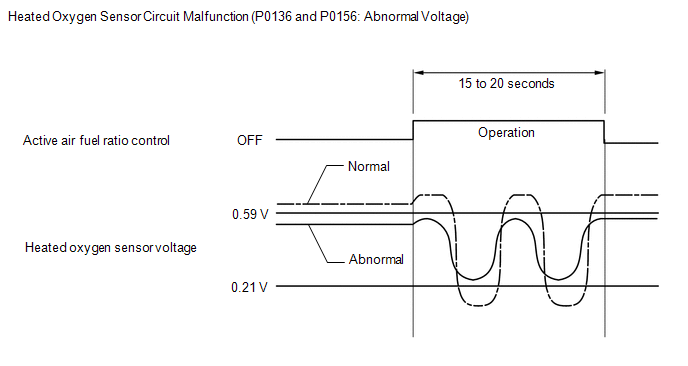
3. Open in Heated Oxygen Sensor Circuit (DTCs P0137 and P0157)
During active air fuel ratio control, the ECM calculates the Oxygen Storage Capacity (OSC)* of the Three-Way Catalytic Converter (TWC) by forcibly regulating the air fuel ratio to become rich or lean.
If the heated oxygen sensor has an open circuit, or the voltage output of the sensor noticeably decreases, the OSC indicates an extraordinarily high value. Even if the ECM attempts to continue regulating the air fuel ratio to become rich or lean, the heated oxygen sensor output does not change.
While performing active air fuel ratio control, when the target air fuel ratio is rich and the heated oxygen sensor voltage output is less than 0.21 V (lean), the ECM interprets this as an abnormally low sensor output voltage and stores DTC P0137 or P0157.
HINT:
*: The TWC has the capability to store oxygen. The OSC and the emission purification capacity of the TWC are mutually related. The ECM determines whether the catalyst has deteriorated, based on the calculated OSC value (See page
![2016 MY Sienna [12/2015 - 08/2016]; 2GR-FE (ENGINE CONTROL): SFI SYSTEM: P0420,P0430; Catalyst System Efficiency Below Threshold (Bank 1)](/t3Portal/stylegraphics/info.gif) ).
).
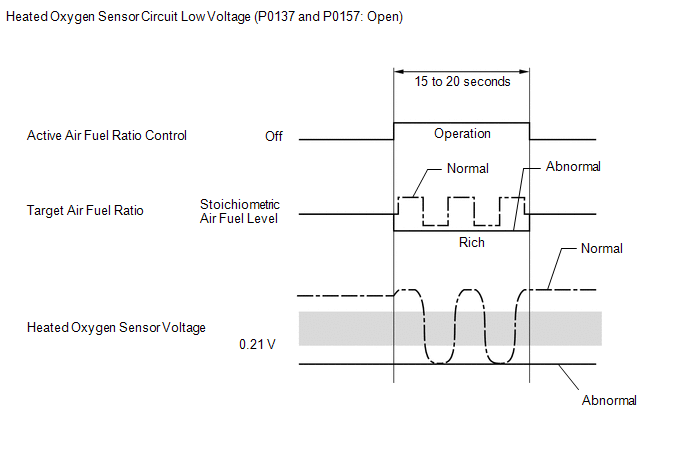
4. High or Low Impedance of Heated Oxygen Sensor (DTCs P0136 and P0156 or P0137 and P0157)
During normal air fuel ratio feedback control, there are small variations in the exhaust gas oxygen concentration. In order to continuously monitor the slight variation of the heated oxygen sensor signal while the engine is running, the impedance* of the sensor is measured by the ECM. The ECM determines that there is a malfunction in the sensor when the measured impedance deviates from the standard range.
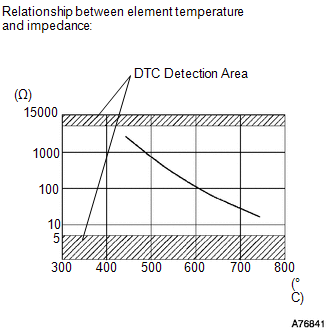
*: The effective resistance in an alternating current electrical circuit.
HINT:
- The impedance cannot be measured using an ohmmeter.
- DTC P0136 or P0156 indicates the deterioration of the heated oxygen sensor. The ECM stores the DTC by calculating the impedance of the sensor when the typical enabling conditions are satisfied (2 driving cycles).
- DTC P0137 or P0157 indicates an open or short circuit in the heated oxygen sensor (2 driving cycles). The ECM stores the DTC when the impedance of the sensor exceeds the threshold 15 kΩ.
5. Extremely High Output Voltage of Heated Oxygen Sensor (DTCs P0138 and P0158)
The ECM continuously monitors the heated oxygen sensor output voltage while the engine is running.
DTC P0138 or P0158 is stored if the heated oxygen sensor voltage output is 1.2 V or higher for 10 seconds or more.
6. Heated Oxygen Sensor Voltage Fuel Cut (DTC P0139 and P0159)
The sensor output voltage drops to less than 0.2 V (extremely lean status) immediately when the vehicle decelerates and fuel cut is operating. If the voltage does not drop to less than 0.2 V when accumulated intake air mass is more than 14 g, the system determines that the sensor response has deteriorated, illuminates the MIL and stores DTC P0139 or P0159.
7. Abnormal Voltage Output of Heated Oxygen Sensor during Fuel Cut from Rich Condition (DTC P013A and P013C)
If the sensor output voltage does not drop from 0.35 to 0.2 V immediately when the vehicle decelerates and fuel cut is operating, the ECM illuminates the MIL and stores the DTC.
MONITOR STRATEGY
|
Related DTCs |
P0136: Heated oxygen sensor (bank 1) voltage check (voltage malfunction) P0136: Heated oxygen sensor (bank 1) circuit continuity check (circuit short) P0137: Heated oxygen sensor (bank 1) voltage check (low voltage) P0137: Heated oxygen sensor (bank 1) circuit continuity check (circuit open) P0138: Heated oxygen sensor (bank 1) circuit continuity check (out of range) P0139: Heated oxygen sensor (bank 1) response rate during fuel cut P0156: Heated oxygen sensor (bank 2) voltage check (voltage malfunction) P0156: Heated oxygen sensor (bank 2) circuit continuity check (circuit short) P0157: Heated oxygen sensor (bank 2) voltage check (low voltage) P0157: Heated oxygen sensor (bank 2) circuit continuity check (circuit open) P0158: Heated oxygen sensor (bank 2) circuit continuity check (out of range) P0159: Heated oxygen sensor (bank 2) response rate during fuel cut |
|
Required Sensors/Components (Main) |
Heated oxygen sensor (sensor 2) |
|
Required Sensors/Components (Related) |
Crankshaft position sensor Engine coolant temperature sensor Mass air flow meter Throttle position sensor Air fuel ratio sensor |
|
Frequency of Operation |
Once per driving cycle: Active air fuel ratio control detection, heated oxygen sensor abnormal voltage during fuel cut. Continuous: Other |
|
Duration |
20 seconds: Heated oxygen sensor voltage check 30 seconds: Heated oxygen sensor circuit continuity check (circuit short) 90 seconds: Heated oxygen sensor circuit continuity check (circuit open) 10 seconds: Heated oxygen sensor circuit continuity check (out of range) 7 seconds: Heated oxygen sensor response rate during fuel cut |
|
MIL Operation |
2 driving cycles |
|
Sequence of Operation |
None |
TYPICAL ENABLING CONDITIONS
All
|
Monitor runs whenever the following DTCs are not stored |
P0016, P0018 (VVT system - misalignment) P0017, P0019 (Exhaust VVT system - misalignment) P0031, P0032, P0051, P0052, P101D, P103D (Air fuel ratio sensor heater) P0037, P0038, P0057, P0058, P102D, P105D (Heated oxygen sensor heater) P0102, P0103 (Mass air flow meter) P0112, P0113 (Intake air temperature sensor) P0115, P0117, P0118 (Engine coolant temperature sensor) P0120, P0121, P0122, P0123, P0220, P0222, P0223, P2135 (Throttle position sensor) P0125 (Insufficient engine coolant temperature for closed loop fuel control) P0128 (Thermostat) P014C, P014D, P014E, P014F, P015A, P015B, P015C, P015D, P2195, P2196, P2197, P2198, P2237, P2238, P2239, P2240, P2241, P2242, P2252, P2253, P2255, P2256 (Air fuel ratio sensor) P0171, P0172, P0174, P0175 (Fuel system) P0300, P0301, P0302, P0303, P0304, P0305, P0306 (Misfire) P0335 (Crankshaft position sensor) P0340 (VVT sensor) P0451, P0452, P0453 (EVAP system) P0500 (Vehicle speed sensor) P219A, P219B, P219C, P219D, P219E, P219F, P21A0, P21A1 (Air fuel ratio imbalance) |
P0136, P0137, P0156 and P0157: Heated Oxygen Sensor Voltage Check (Voltage Malfunction and Low Voltage)
|
Battery voltage |
11 V or higher |
|
Intake air temperature |
-10°C (14°F) or higher |
|
Engine coolant temperature |
75°C (167°F) or higher |
|
Atmospheric pressure |
76 kPa(abs) [570 mmHg(abs)] or higher |
|
Idling |
Off |
|
Engine speed |
Less than 3200 rpm |
|
Air fuel ratio sensor status |
Activated |
|
Fuel system status |
Closed loop |
|
Engine load |
10% or higher, and less than 85% |
|
Shift position |
3rd or higher |
P0136 and P0156: Heated Oxygen Sensor Circuit Continuity Check (Circuit Short)
|
Battery voltage |
11 V or higher |
|
Estimated sensor temperature |
Less than 700°C (1292°F) |
|
ECM monitor |
Completed |
|
DTC P0607 |
Not stored |
P0137 and P0157: Heated Oxygen Sensor Circuit Continuity Check (Circuit Open)
|
Battery voltage |
11 V or higher |
|
Estimated sensor temperature |
450°C (842°F) or higher, and less than 750°C (1382°F) |
|
DTC P0607 |
Not stored |
P0138 and P0158: Heated Oxygen Sensor Circuit Continuity Check (Out of Range)
|
Battery voltage |
11 V or higher |
|
Time after engine start |
2 seconds or more |
P0139 and P0159: Heated Oxygen Sensor Response Rate During Fuel Cut
|
Engine coolant temperature |
75°C (167°F) or higher |
|
Catalyst temperature |
400°C (752°F) or higher |
|
Fuel cut |
On |
P013A and P013C: Heated Oxygen Sensor Response Rate During Fuel Cut from Rich Condition
|
Battery voltage |
11 V or higher |
|
Engine coolant temperature |
75°C (167°F) or higher |
|
Estimated catalyst temperature |
400°C (752°F) or higher |
|
Fuel cut |
On |
TYPICAL MALFUNCTION THRESHOLDS
P0136 and P0156: Heated Oxygen Sensor Voltage Check (Voltage Malfunction)
|
All of following conditions (a), (b) and (c) met |
- |
|
(a) OSC (Oxygen Storage Capacity) of catalyst |
2.1 g or more |
|
(b) Rear oxygen sensor voltage |
0.21 V or higher, and less than 0.71 V |
|
(b) Commanded air fuel ratio |
14.3 or less |
P0137 and P0157: Heated Oxygen Sensor Voltage Check (Low Voltage)
|
All of following conditions (a), (b) and (c) met |
- |
|
(a) OSC (Oxygen Storage Capacity) of catalyst |
2.1 g or more |
|
(b) Rear oxygen sensor voltage |
Less than 0.21 V |
|
(c) Commanded air fuel ratio |
14.3 or less |
P0136 and P0156: Heated Oxygen Sensor Circuit Continuity Check (Circuit Short)
|
Duration of following condition |
30 seconds or more |
|
Rear oxygen sensor impedance |
Less than 5 Ω |
P0137 and P0157: Heated Oxygen Sensor Circuit Continuity Check (Circuit Open)
|
Duration of following condition |
90 seconds or more |
|
Rear oxygen sensor impedance |
15 kΩ or higher |
P0138 and P0158: Heated Oxygen Sensor Circuit Continuity Check (Out of Range)
|
Duration of following condition |
10 seconds or more |
|
Rear oxygen sensor voltage |
1.2 V or higher |
P0139 and P0159: Heated Oxygen Sensor Response Rate During Fuel Cut
|
Total air-flow volume reached after start of fuel-cut while rear heated oxygen sensor voltage remains at 0.2 V or higher |
More than 13 g |
P013A and P013C: Heated Oxygen Sensor Response Rate During Fuel Cut from Rich Condition
|
Duration that rear oxygen sensor voltage drops from 0.35 V to 0.2 V during fuel-cut (Normalized) |
1 second or more |
CONFIRMATION DRIVING PATTERN
HINT:
- This confirmation driving pattern is used in the "Perform Confirmation Driving Pattern" procedure of the following diagnostic troubleshooting procedure.
- Performing this confirmation driving pattern will activate the heated oxygen sensor monitor (The catalyst monitor is performed simultaneously). This is very useful for verifying the completion of a repair.
P0136, P0137, P0138, P0156, P0157 and P0158
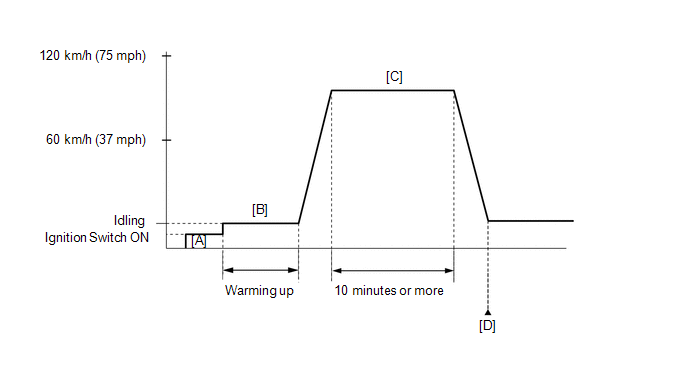
- Connect the Techstream to the DLC3.
- Turn the ignition switch to ON and turn the Techstream on.
-
Clear DTCs (even if no DTCs are stored, perform the clear DTC procedure) (See page
![2016 MY Sienna [12/2015 - 08/2016]; 2GR-FE (ENGINE CONTROL): SFI SYSTEM: DTC CHECK / CLEAR](/t3Portal/stylegraphics/info.gif) ).
).
- Turn the ignition switch off and wait for at least 30 seconds.
- Turn the ignition switch to ON and turn the Techstream on [A].
- Start the engine and warm it up until the engine coolant temperature reaches 75°C (167°F) or higher [B].
-
With the shift lever in D, drive the vehicle at 60 to 120 km/h (37 to 75 mph) for 10 minutes or more [C].
CAUTION:
When performing the confirmation driving pattern, obey all speed limits and traffic laws.
- Enter the following menus: Powertrain / Engine / Trouble Codes [D].
-
Read the pending DTCs.
HINT:
- If a pending DTC is output, the system is malfunctioning.
- If a pending DTC is not output, perform the following procedure.
- Enter the following menus: Powertrain / Engine / Utility / All Readiness.
- Input the DTC: P0136, P0137, P0138, P0156, P0157 or P0158.
-
Check the DTC judgment result.
Techstream Display
Description
NORMAL
- DTC judgment completed
- System normal
ABNORMAL
- DTC judgment completed
- System abnormal
INCOMPLETE
- DTC judgment not completed
- Perform driving pattern after confirming DTC enabling conditions
N/A
- Unable to perform DTC judgment
- Number of DTCs which do not fulfill DTC preconditions has reached ECU memory limit
HINT:
- If the judgment result shows NORMAL, the system is normal.
- If the judgment result shows ABNORMAL, the system has a malfunction.
- If the judgment result shows INCOMPLETE or N/A, perform steps [C] and [D] again.
-
If no pending DTC is output, perform a universal trip and check for permanent DTCs (See page
![2016 MY Sienna [12/2015 - 08/2016]; 2GR-FE (ENGINE CONTROL): SFI SYSTEM: DTC CHECK / CLEAR](/t3Portal/stylegraphics/info.gif) ).
).
HINT:
- If a permanent DTC is output, the system is malfunctioning.
- If no permanent DTC is output, the system is normal.
P0139, P013A, P013C and P0159
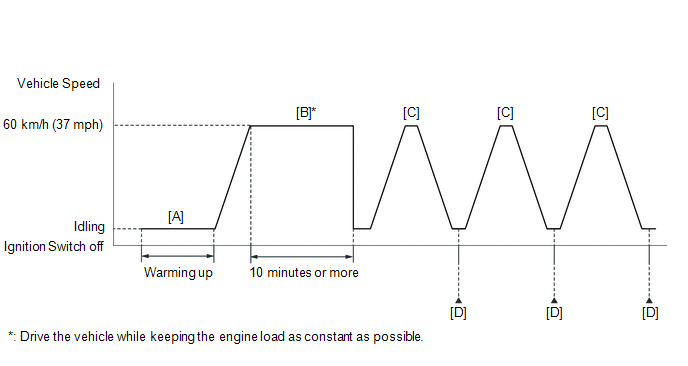
- Connect the Techstream to the DLC3.
- Turn the ignition switch to ON and turn the Techstream on.
- Clear the DTCs (even if no DTCs are stored, perform the clear DTC procedure).
- Turn the ignition switch off and wait for at least 30 seconds.
- Turn the ignition switch to ON and turn the Techstream on.
- Enter the following menus: Powertrain / Engine / Monitor / Current Monitor.
- Check that Catalyst Efficiency / Current is Incomplete.
-
Start the engine and warm it up until the engine coolant temperature is 75°C (167°F) or higher with the shift lever in P [A].
HINT:
In order to keep the idling stable, turn off the A/C and all other electric loads and do not perform any shift operations.
-
Drive the vehicle at approximately 60 km/h (37 mph) for 10 minutes or more [B].
CAUTION:
When performing the confirmation driving pattern, obey all speed limits and traffic laws.
HINT:
Drive the vehicle while keeping the engine load as constant as possible.
-
With the shift lever in S position, drive the vehicle at 60 km/h (37 mph), and then decelerate the vehicle by releasing the accelerator pedal for 5 seconds or more to perform the fuel-cut [C].
CAUTION:
When performing the confirmation driving pattern, obey all speed limits and traffic laws.
- Enter the following menus: Powertrain / Engine / Monitor / Current Monitor / O2 Sensor / RL F/C B1S2, RL F/C B2S2 [D].
-
Check the Test Value for RL F/C B1S2, RL F/C B2S2.
HINT:
If Test Value displays 0, perform step [C] until it displays a value larger than 0, as the O2 Sensor monitor is not finished.
- Repeat step [C] 2 times or more in one driving cycle.
- Enter the following menus: Powertrain / Engine / Trouble Codes.
-
Read the pending DTCs.
HINT:
- If a pending DTC is output, the system is malfunctioning.
- If a pending DTC is not output, perform the following procedure.
- Enter the following menus: Powertrain / Engine / Utility / All Readiness.
- Input the DTC: P0139, P013A, P013C or P0159.
-
Check the DTC judgment result.
Techstream Display
Description
NORMAL
- DTC judgment completed
- System normal
ABNORMAL
- DTC judgment completed
- System abnormal
INCOMPLETE
- DTC judgment not completed
- Perform driving pattern after confirming DTC enabling conditions
N/A
- Unable to perform DTC judgment
- Number of DTCs which do not fulfill DTC preconditions has reached ECU memory limit
HINT:
- If the judgment result shows ABNORMAL, the system has a malfunction.
- If the judgment result shows NORMAL, the system is normal.
- If the judgment result shows INCOMPLETE or N/A, drive the vehicle with the shift lever in S, and then perform steps [C] and [D] again.
-
If no pending DTC is output, perform a universal trip and check for permanent DTCs (See page
![2016 MY Sienna [12/2015 - 08/2016]; 2GR-FE (ENGINE CONTROL): SFI SYSTEM: DTC CHECK / CLEAR](/t3Portal/stylegraphics/info.gif) ).
).
HINT:
- If a permanent DTC is output, the system is malfunctioning.
- If no permanent DTC is output, the system is normal.
WIRING DIAGRAM

CAUTION / NOTICE / HINT
HINT:
Malfunctioning areas can be identified by performing the Control the Injection Volume for A/F Sensor function provided in the Active Test. The Control the Injection Volume for A/F Sensor function can help to determine whether the air fuel ratio sensor, heated oxygen sensor and other potential trouble areas are malfunctioning.
The following instructions describe how to conduct the Control the Injection Volume for A/F Sensor operation using the Techstream.
- Connect the Techstream to the DLC3.
- Start the engine.
- Turn the Techstream on.
- Warm up the engine at an engine speed of 2500 rpm for approximately 90 seconds.
- Enter the following menus: Powertrain / Engine / Active Test / Control the Injection Volume for A/F Sensor / AFS Voltage B1S1 and O2S B1S2 or AFS Voltage B2S1 and O2S B2S2.
- Perform the Active Test operation with the engine idling (press the RIGHT or LEFT button to change the fuel injection volume).
- Monitor the output voltages of the air fuel ratio and heated oxygen sensors (AFS Voltage B1S1 and O2S B1S2 or AFS Voltage B2S1 and O2S B2S2) displayed on the Techstream.
HINT:
- Change the fuel injection volume within the range of -12.5% to 12.5%. The injection volume can be changed in fine gradations.
- Each sensor reacts in accordance with increases and decreases in the fuel injection volume.
|
Techstream Display (Sensor) |
Injection Volume |
Status |
Voltage |
|---|---|---|---|
|
AFS Voltage B1S1 AFS Voltage B2S1 (Air fuel ratio) |
12.5% |
Rich |
Below 3.1 V |
|
-12.5% |
Lean |
Higher than 3.4 V |
|
|
O2S B1S2 O2S B2S2 (Heated oxygen) |
12.5% |
Rich |
Higher than 0.55 V |
|
-12.5% |
Lean |
Below 0.4 V |
NOTICE:
The air fuel ratio sensor has an output delay of a few seconds and the heated oxygen sensor has a maximum output delay of approximately 20 seconds.
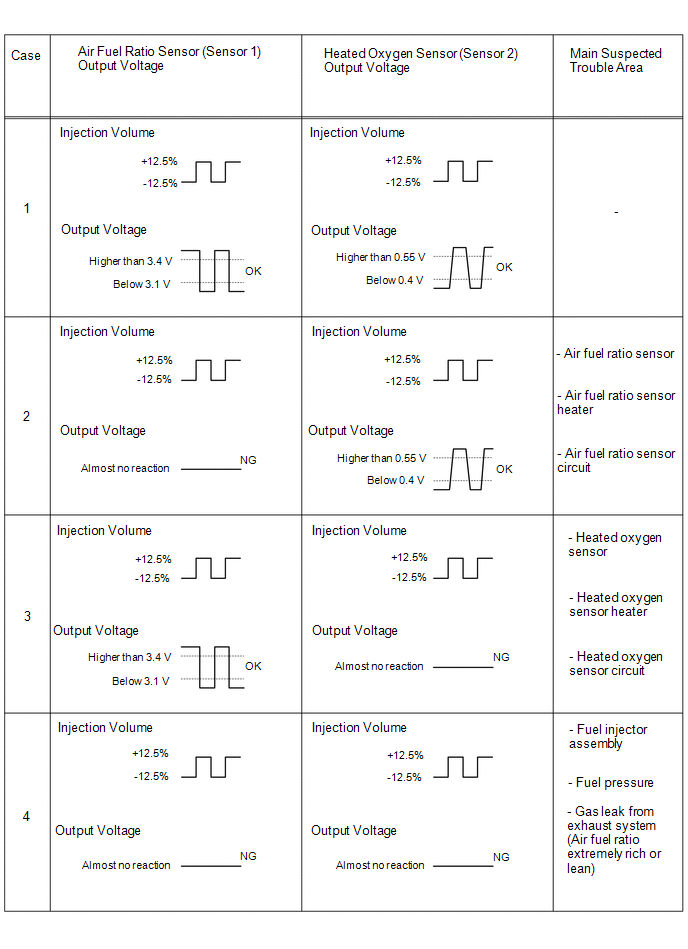
- Following the Control the Injection Volume for A/F Sensor procedure enables technicians to check and graph the voltage outputs of both the air fuel ratio and heated oxygen sensors.
- To display the graph, enter the following menus: Powertrain / Engine / Active Test / Control the Injection Volume for A/F Sensor / AFS Voltage B1S1 and O2S B1S2 or AFS Voltage B2S1 and O2S B2S2; and then press the graph button on the Data List view.
NOTICE:
Inspect the fuses for circuits related to this system before performing the following inspection procedure.
HINT:
-
Bank 1 refers to the bank that includes the No. 1 cylinder*.
*: The No. 1 cylinder is the cylinder which is farthest from the transaxle.
- Bank 2 refers to the bank that does not include the No. 1 cylinder.
- Sensor 1 refers to the sensor closest to the engine assembly.
- Sensor 2 refers to the sensor farthest away from the engine assembly.
- Read freeze frame data using the Techstream. The ECM records vehicle and driving condition information as freeze frame data the moment a DTC is stored. When troubleshooting, freeze frame data can help determine if the vehicle was moving or stationary, if the engine was warmed up or not, if the air fuel ratio was lean or rich, and other data from the time the malfunction occurred.
PROCEDURE
|
1. |
READ OUTPUT DTC |
(a) Connect the Techstream to the DLC3.
(b) Turn the ignition switch to ON.
(c) Turn the Techstream on.
(d) Enter the following menus: Powertrain / Engine / Trouble Codes.
(e) Read the DTCs.
Result
|
Result |
Proceed to |
|---|---|
|
DTC P0138 or P0158 is output |
A |
|
DTC P0137 or P0157 is output |
B |
|
DTC P0136 or P0156 is output |
C |
|
P0139, P013A, P013C or P0159 is output |
D |
|
P0136, P0137, P0138, P0139, P013A, P013C, P0156, P0157, P0158 or P0159 and other DTCs are output |
E |
HINT:
If any DTCs other than P0136, P0137, P0138, P0139, P013A, P013C, P0156, P0157, P0158 and P0159 are output, troubleshoot those DTCs first.
| B |

|
| C |

|
| D |

|
| E |

|
|
|
2. |
INSPECT HEATED OXYGEN SENSOR (CHECK FOR SHORT) |
|
(a) Disconnect the D38 or B33 heated oxygen sensor connector. |
|
(b) Measure the resistance according to the value(s) in the table below.
Standard Resistance:
|
Tester Connection |
Condition |
Specified Condition |
|---|---|---|
|
2 (+B) - 4 (E2) |
Always |
10 kΩ or higher |
|
2 (+B) - 3 (OX1B) |
Always |
10 kΩ or higher |
|
2 (+B) - 4 (E2) |
Always |
10 kΩ or higher |
|
2 (+B) - 3 (OX2B) |
Always |
10 kΩ or higher |
Text in Illustration
|
*a |
Components without harness connected (Heated Oxygen Sensor) |
|
*b |
(for Bank 1) |
|
*c |
(for Bank 2) |
| NG |

|
|
|
3. |
CHECK HARNESS AND CONNECTOR (CHECK FOR SHORT) |
(a) Turn the ignition switch off and wait for 5 minutes or more.
(b) Disconnect the B1 ECM connector.
(c) Measure the resistance according to the value(s) in the table below.
Standard Resistance:
|
Tester Connection |
Condition |
Specified Condition |
|---|---|---|
|
B1-45 (HT1B) - B1-114 (OX1B) |
Always |
10 kΩ or higher |
|
B1-44 (HT2B) - B1-112 (OX2B) |
Always |
10 kΩ or higher |
| OK |

|
| NG |

|
REPAIR OR REPLACE HARNESS OR CONNECTOR |
|
4. |
PERFORM ACTIVE TEST USING TECHSTREAM (CONTROL THE INJECTION VOLUME FOR A/F SENSOR) |
(a) Connect the Techstream to the DLC3.
(b) Start the engine.
(c) Turn the Techstream on.
(d) Warm up the engine.
(e) Enter the following menus: Powertrain / Engine / Active Test / Control the Injection Volume for A/F Sensor / O2S B1S2 or O2S B2S2.
(f) Change the fuel injection volume using the Techstream, and monitor the voltage output of the heated oxygen sensor displayed on the Techstream.
HINT:
- The Control the Injection Volume for A/F Sensor operation lowers the fuel injection volume by 12.5% or increases the injection volume by 12.5%.
- The heated oxygen sensor has a maximum output delay of approximately 20 seconds.
Standard voltage:
Fluctuates between 0.4 V or less, and 0.55 V or higher.
| NG |

|
|
|
5. |
PERFORM ACTIVE TEST USING TECHSTREAM (CONTROL THE INJECTION VOLUME FOR A/F SENSOR) |
(a) Connect the Techstream to the DLC3.
(b) Start the engine.
(c) Turn the Techstream on.
(d) Warm up the engine.
(e) Enter the following menus: Powertrain / Engine / Active Test / Control the Injection Volume for A/F Sensor / AFS Voltage B1S1 and O2S B1S2 or AFS Voltage B2S1 and O2S B2S2.
(f) Change the fuel injection volume using the Techstream, and monitor the voltage output of air fuel ratio and heated oxygen sensors displayed on the Techstream.
HINT:
- Perform the Active Test operation with the engine idling (press the -12.5% or 12.5% button to change the fuel injection volume).
- The air fuel ratio sensor is displayed as AFS Voltage B1S1 or AFS Voltage B2S1, and the heated oxygen sensor is displayed as O2S B1S2 or O2S B2S2 on the Techstream.
- The air fuel ratio sensor has an output delay of a few seconds and the heated oxygen sensor has a maximum output delay of approximately 20 seconds.
- If the sensor output voltage does not change (almost no reaction) while performing the Active Test, the sensor may be malfunctioning.
Result
|
Techstream Display (Sensor) |
Voltage Variation |
Proceed to |
|---|---|---|
|
AFS Voltage B1S1 AFS Voltage B2S1 (Air fuel ratio) |
Alternates between higher and less than 3.3 V |
OK |
|
Remains at higher than 3.3 V |
NG |
|
|
Remains at less than 3.3 V |
NG |
HINT:
A normal heated oxygen sensor voltage (O2S B1S2 or O2S B2S2) reacts in accordance with increases and decreases in fuel injection volumes. When the air fuel ratio sensor voltage (AFS Voltage B1S1 or AFS Voltage B2S1) remains at either less or higher than 3.3 V despite the heated oxygen sensor indicating a normal reaction, the air fuel ratio sensor is malfunctioning.

| OK |

|
| NG |

|
|
6. |
CHECK FOR EXHAUST GAS LEAK |
(a) Check for exhaust gas leaks.
OK:
No gas leaks.
HINT:
Perform "Inspection After Repair" after repairing or replacing the exhaust system (See page
![2016 MY Sienna [12/2015 - 08/2016]; 2GR-FE (ENGINE CONTROL): SFI SYSTEM: INITIALIZATION](/t3Portal/stylegraphics/info.gif) ).
).
| NG |

|
REPAIR OR REPLACE EXHAUST GAS LEAK POINT |
|
|
7. |
INSPECT HEATED OXYGEN SENSOR (HEATER RESISTANCE) |
| NG |

|
|
|
8. |
CHECK HARNESS AND CONNECTOR (HEATED OXYGEN SENSOR - ECM) |
(a) Disconnect the D38 and B33 heated oxygen sensor connectors.
(b) Disconnect the B1 ECM connector.
(c) Measure the resistance according to the value(s) in the table below.
Standard Resistance:
|
Tester Connection |
Condition |
Specified Condition |
|---|---|---|
|
D38-1 (HT1B) - B1-45 (HT1B) |
Always |
Below 1 Ω |
|
D38-3 (OX1B) - B1-114 (OX1B) |
Always |
Below 1 Ω |
|
D38-4 (E2) - B1-115 (EX1B) |
Always |
Below 1 Ω |
|
B33-1 (HT2B) - B1-44 (HT2B) |
Always |
Below 1 Ω |
|
B33-3 (OX2B) - B1-112 (OX2B) |
Always |
Below 1 Ω |
|
B33-4 (E2) - B1-113 (EX2B) |
Always |
Below 1 Ω |
|
D38-1 (HT1B) or B1-45 (HT1B) - Body ground |
Always |
10 kΩ or higher |
|
D38-3 (OX1B) or B1-114 (OX1B) - Body ground |
Always |
10 kΩ or higher |
|
B33-1 (HT2B) or B1-44 (HT2B) - Body ground |
Always |
10 kΩ or higher |
|
B33-3 (OX2B) or B1-112 (OX2B) - Body ground |
Always |
10 kΩ or higher |
| NG |

|
REPAIR OR REPLACE HARNESS OR CONNECTOR |
|
|
9. |
REPLACE HEATED OXYGEN SENSOR |
(a) Replace the heated oxygen sensor (See page
![2016 MY Sienna [12/2015 - 08/2016]; 2GR-FE (ENGINE CONTROL): HEATED OXYGEN SENSOR: REMOVAL](/t3Portal/stylegraphics/info.gif) ).
).
|
|
10. |
PERFORM CONFIRMATION DRIVING PATTERN |
(a) Perform the Confirmation Driving Pattern (P0136, P0137, P0138, P0156, P0157 and P0158).
|
|
11. |
CHECK WHETHER DTC OUTPUT RECURS (DTC P0136, P0137, P0156 OR P0157) |
(a) Connect the Techstream to the DLC3.
(b) Turn the ignition switch to ON.
(c) Turn the Techstream on.
(d) Enter the following menus: Powertrain / Engine / Utility / All Readiness.
(e) Input the DTC: P0136, P0137, P0156 or P0157.
(f) Check that the DTC monitor is NORMAL. If the DTC monitor is INCOMPLETE, perform the drive pattern again but increase the vehicle speed.
Result
|
Result |
Proceed to |
|---|---|
|
ABNORMAL (DTC P0136, P0137, P0156 or P0157 is output) |
A |
|
NORMAL (DTC is not output) |
B |
| A |

|
| B |

|
END |
|
12. |
REPLACE AIR FUEL RATIO SENSOR |
(a) Replace the air fuel ratio sensor (See page
![2016 MY Sienna [12/2015 - 08/2016]; 2GR-FE (ENGINE CONTROL): AIR FUEL RATIO SENSOR: REMOVAL](/t3Portal/stylegraphics/info.gif) ).
).
HINT:
Perform "Inspection After Repair" after replacing the air fuel ratio sensor (See page
![2016 MY Sienna [12/2015 - 08/2016]; 2GR-FE (ENGINE CONTROL): SFI SYSTEM: INITIALIZATION](/t3Portal/stylegraphics/info.gif) ).
).
|
|
13. |
PERFORM CONFIRMATION DRIVING PATTERN |
(a) Perform the Confirmation Driving Pattern (P0136, P0137, P0138, P0156, P0157 and P0158).
|
|
14. |
CHECK WHETHER DTC OUTPUT RECURS (DTC P0136 OR P0156) |
(a) Connect the Techstream to the DLC3.
(b) Turn the ignition switch to ON.
(c) Turn the Techstream on.
(d) Enter the following menus: Powertrain / Engine / Utility / All Readiness.
(e) Input the DTC: P0136 or P0156.
(f) Check that the DTC monitor is NORMAL. If the DTC monitor is INCOMPLETE, perform the drive pattern again but increase the vehicle speed.
Result
|
Result |
Proceed to |
|---|---|
|
NORMAL (DTC is not output) |
A |
|
ABNORMAL (DTC P0136 or P0156 is output) |
B |
HINT:
Perform "Inspection After Repair" after replacing the heated oxygen sensor (See page
![2016 MY Sienna [12/2015 - 08/2016]; 2GR-FE (ENGINE CONTROL): SFI SYSTEM: INITIALIZATION](/t3Portal/stylegraphics/info.gif) ).
).
| A |

|
END |
| B |

|
|
15. |
CHECK FOR EXHAUST GAS LEAK |
(a) Check for exhaust gas leaks.
OK:
No gas leaks.
HINT:
Perform "Inspection After Repair" after replacing the exhaust system (See page
![2016 MY Sienna [12/2015 - 08/2016]; 2GR-FE (ENGINE CONTROL): SFI SYSTEM: INITIALIZATION](/t3Portal/stylegraphics/info.gif) ).
).
| NG |

|
REPAIR OR REPLACE EXHAUST GAS LEAK POINT |
|
|
16. |
INSPECT HEATED OXYGEN SENSOR (CHECK FOR SHORT) |
(a) Turn the ignition switch off and wait for 5 minutes or more.
(b) Disconnect the B1 ECM connector.
(c) Measure the resistance according to the value(s) in the table below.
Standard Resistance:
|
Tester Connection |
Condition |
Specified Condition |
|---|---|---|
|
B1-45 (HT1B) - B1-114 (OX1B) |
Always |
10 kΩ or higher |
|
B1-44 (HT2B) - B1-112 (OX2B) |
Always |
10 kΩ or higher |
| NG |

|
REPAIR OR REPLACE HARNESS OR CONNECTOR |
|
|
17. |
PERFORM CONFIRMATION DRIVING PATTERN |
(a) Perform the Confirmation Driving Pattern (P0139 and P0159).
|
|
18. |
READ DTC OUTPUT (DTC P0139, P013A, P013C OR P0159 IS OUTPUT AGAIN) |
(a) Connect the Techstream to the DLC3.
(b) Turn the ignition switch to ON.
(c) Turn the Techstream on.
(d) Enter the following menus: Powertrain / Engine / Utility / All Readiness.
(e) Input DTCs: P0139, P013A, P013C or P0159.
(f) Check that the DTC monitor is NORMAL. If the DTC monitor is INCOMPLETE, perform the drive pattern again but increase the vehicle speed.
Result
|
Result |
Proceed to |
|---|---|
|
ABNORMAL (DTC P0139 or P0159 is output) |
A |
|
NORMAL (DTC is not output) |
B |
| A |

|
| B |

|
|
|
|

